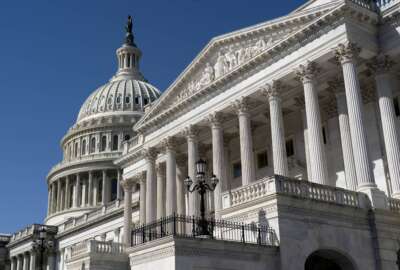
Agencies know what to do during a government shutdown, but default is new territory
A federal judge in Massachusetts will hear oral arguments next Wednesday in a lawsuit that argues both that federal employees must be paid even if Congress...
If the U.S. Treasury runs out of money to pay all the government’s bills because of the debt limit impasse, no one’s exactly sure what it would mean for federal agencies and employees — after all, it’s never happened before. But key federal stakeholders want answers before things get to that point, and at least one is taking the government to court over it.
A federal judge in Massachusetts will hear oral arguments next Wednesday in a lawsuit that argues both that federal employees must be paid even if Congress doesn’t increase the debt ceiling, and that the ceiling itself is unconstitutional.
The plaintiff, the National Association of Government Employees, is asking the court to rule that the 1917 law that created the debt ceiling violates the Constitution’s separation of powers. NAGE argues that if the Treasury runs out of sufficient cash to pay all of the government’s bills, the president would be forced to make unilateral decisions on how federal money is spent — a power the Constitution reserves for Congress.
In its emergency petition, NAGE argued that putting the president in the position of deciding which bills to pay amounts to a line-item veto, a concept the Supreme Court ruled unconstitutional in 1998.
The union’s attorneys argued the debt limit, combined with the fact that only Congress can decide how to allocate federal funds, puts President Biden and Treasury Secretary Janet Yellen in an “impossible position.”
“They are required to pay bondholders as payment on the public debt comes due, and continue the spending that Congress has approved for federal programs, and comply with the debt limit,” NAGE wrote in its motion for a preliminary injunction. “[The administration] cannot do all three things at once … and if it is assumed that they prioritize payment to holders of government debt, they also have no direction as to what programs to cut to ensure that holders of the debt will be paid. Without any guidance from Congress, they are left to decide what cuts in federal programs, including Social Security, Medicare, the Civil Service, or military spending, to make up the estimated shortfall of $0.3 trillion to $0.6 trillion by the end of this fiscal year.”
David Berteau, the president of the Professional Services Council, a federal contractors’ trade association that is not involved in the case, agreed a default situation would put the administration in a scenario in which it would need to decide which laws to comply with and which ones to violate.
“The current Supreme Court interpretation [of Article I] is if the money is appropriated, it has to be obligated and expended,” Berteau said. “But under Article II, the president has the requirement to faithfully execute the laws, one of which is you can’t exceed the debt ceiling. You can’t do both, so there will have to be some choices.”
But PSC argues the administration still needs to give agencies and federal contractors a lot more clarity about what those choices would be.
Even though the government has reached the brink of a default crisis numerous times, there’s still no playbook at all for how the federal government would continue to operate.
Stephanie Kostro, the association’s vice president for policy, said there are whispers of informal guidance at individual agencies, but each agency seems to be thinking about the problem differently.
“It’s quite inconsistent across the government. You’ve got some agencies treating this like a shutdown, thinking about stop work orders, determining who’s essential and who’s not,” she said. “We’ve got other agencies thinking, ‘Oh, we have appropriations, therefore we have the cash,’ but that’s not exactly what this situation is either. And then we’ve got a third subset of folks who are waiting for [the Office of Management and Budget] to come up with guidance. They want that so that they can that they have faith and trust and confidence that they can continue to do their jobs.”
One possible reason no such guidance has been issued is that the White House’s official position is a default simply cannot and will not happen.
“I’ve made clear time and again that defaulting on our national debt is not an option,” President Biden said during remarks in the White House’s rose garden Thursday afternoon. “The American people deserve to know that the Social Security payments will be there, the veterans hospital will remain open, and that economic progress will be made. Default puts all of that at risk. Congressional leaders understand that, and they’ve all agreed there will be no default.”
But there were few signs that an agreement would be reached by June 1. That’s the date by which Treasury Secretary Janet Yellen has said the Treasury could face a federal default, though the exact date is difficult to estimate. House lawmakers returned to their districts on Thursday, with no plans to return until Tuesday.
And with only about a week to go before a potential default situation, PSC argues it’s irresponsible not to plan for that eventuality, and to give agencies clarity about how it would work.
For one thing, Berteau said OMB needs to make clear that a default situation is very different from a government shutdown.
In this case, agencies still have legally-authorized appropriations for the rest of the fiscal year, even though Treasury may not have enough cash on hand to pay those obligations when they’re due.
“A shutdown comes from the absence of appropriations, and this is not an absence of appropriations,” he said. “But [default] poses a risk to the government and to the entire global economic structure, and to minimize that risk, the government needs to act in ways that maximize trust and faith. One of the ways in which we think that can be done is to keep the government fully operating. Every mission, every function, every activity should continue going. This is sort of the opposite of what you do in a government shutdown, where you decide what’s essential and what’s not essential; what needs to keep going and what needs to not keep going.”
In its letter to OMB, PSC also asked the administration to make clear how spending prioritization decisions would happen in a scenario when there’s not enough cash to go around.
One of the few things that’s currently known about how the prioritization would work is that interest payments on outstanding Treasury bonds would come first. That belief is based in large part on a contingency plan that was developed in 2011 during a similar debt ceiling standoff — the one that eventually led to serious government spending cuts under the Budget Control Act.
As for the next priorities, Berteau said those decisions should be made by the president each day. He said some agencies are currently under the impression that they’d have the flexibility to make prioritization decisions within their own budgets.
“We have agencies that have told us, ‘We think we can pay all our bills.’ But they sort of forget that they don’t write the checks, the Treasury Department writes the checks,” he said. “We think OMB should remind agencies that the only place those priorities are set is from the White House, by direction of the President, and that individual programs and individual agencies should not be making prioritization decisions. That needs to be done across the federal government.”
In the absence of a public plan from the White House, PSC said it’s been doing its best to advise companies on what they should be doing to prepare for a default crisis.
Without enough cash to go around, there’s bound to be a prioritization process of one kind or another — so the best thing vendors can do is make sure their invoices are submitted as quickly as possible, Berteau said.
“There’s at least an assumption that if your invoices aren’t in, they’re not going to be in line. So keep your invoices current, and most importantly, follow up with the agencies after you’ve submitted the invoices to make sure there are no unanswered questions and that they’re ready to approve those invoices,” he said. “Our second line was to talk to your customers … they’re probably not going to get guidance from on high, at least not right away, so ask them what they need from you to be able to make the case internally to keep the programs operating. And the third is to pay attention to your cash situation. One of the things that we saw during the 35-day partial government shutdown is that banks’ credit lines to government contractors tightened up as the shutdown continued with no clear idea of when it was going to end. We are already hearing from our member companies that that is happening again in some cases. And this would be particularly damaging and devastating to small businesses that just don’t have the access to cash that a large business does.”
Copyright © 2025 Federal News Network. All rights reserved. This website is not intended for users located within the European Economic Area.
Jared Serbu is deputy editor of Federal News Network and reports on the Defense Department’s contracting, legislative, workforce and IT issues.
Follow @jserbuWFED
Related Stories





